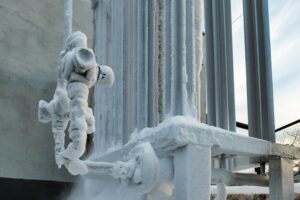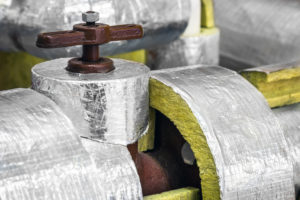Your Guide to Freeze Protection
Last updated on December 17th, 2024 at 08:22 am
Freeze protection: With many weather conditions being unpredictable year after year, many companies look at protecting their mediums. Approaches change depending on whether they are water-based, or oil-based from freezing through the winter months. In a study conducted by the University of California for Atmospheric Science in 2000*, it was regarded that more economic losses occur due to freeze damage in the United States more than any other weather-related hazard.
The industries that require freeze protection
The most common industries generally affected over the winter months are the oil and gas industry, Water treatment plants, Transportation industry, agriculture, and mining industry.
These industries have many applications that require storing their product outside. Thus exposing it to extreme temperatures for a long period of time.
With water-based products, freeze protection is vital as they begin to crystallize and freeze at 0°C / 32°F / 273.15K. Keep in mind, that providing a heat source alone is not always the best solution. It’s important that tanks or reservoirs are properly insulated to assure that the medium doesn’t freeze.
Freeze Protection of Oil-Based Products
When dealing with oil-based products, it becomes more difficult the colder the weather. Fuel oils (both clear Diesel fuel and dyed home heating oil) do not freeze, but rather turn into gel or a thicker wax. This process begins to occur below 32°F, and continuously hardens the colder it gets.
Once the temperature drops below 15°F the wax in the fuel begins to crystallize and separate from the oil. This makes it extremely difficult to handle or to remove from its container. In certain applications where these fuel oils are transported through a pipeline, it is highly recommended to insulate any piping that may be exposed to extreme temperature and winds, in order to avoid any clogged pipes.
For motor oil, Gear oil and hydraulic oil each has a different freezing temperature range. For instance, motor working oil (10W30) freezes at –20°F, but from 50°F, to 0°F the viscosity of the oil becomes more and more difficult to handle. With gear oil and hydraulic oil it’s freezing temperature is set to –10°F. And, same as motor oil, it becomes more viscous the colder it gets. However there are certain oils that do work below freezing temperature and those are generally the thicker kind of motor oil’s like 15W30, which freezes at -55°F.
The definition of freeze protection
 Freeze protection means that you don’t want your tank’s temperature to go below 32°F, or else the liquid will freeze. To best protect against freezing, insulate your tank. This allows having a heat loss of approximately 5 percent, versus a 35-45 percent heat loss without any insulation.
Freeze protection means that you don’t want your tank’s temperature to go below 32°F, or else the liquid will freeze. To best protect against freezing, insulate your tank. This allows having a heat loss of approximately 5 percent, versus a 35-45 percent heat loss without any insulation.
Since your tank holds a certain amount of gallons, and you’ve decided to only use one heater, insulating your tank is a must. This will avoid having two different temperature zones, in your tank.
Keep in mind that if your heater is on one side, heat transfer will take some time before getting to the other side, but with insulation, it will get there faster. The most efficient way, however, is to install two or more heaters depending on the size of your tank.
The most difficult part of protecting your medium from freezing is determining how much power is enough. The first thing you need is to understand is your tank’s environment and its surroundings. Consult historical charts to determine how cold your location gets with and without the wind.
However, the weather is always unpredictable, and you have to keep in mind that if your tank is well insulated, and the heater is working with the proper controls then during the freeze period you should be well protected to bare the storm. In certain regions around the world the temperature will reach below 32°F, and stay below 32°F for a considerable amount of time, this is where the right amount of power and insulation for your tank play their most important role in protecting you against freezing conditions.
Heating formulas
These are the formulas that are generally used in the heating industry to determine how many Kilowatts would be required to heat a tank filled with either water or oil:
§ [Formula for heating water in a tank]
(# Of Gallons) x (Delta Temperature in Fahrenheit) / (372) x (# hours) = Kilowatts required
§ [Formula for heating oil in a tank]
(# Of Gallons) x (Delta Temperature in Fahrenheit) / (860) x (# hours) = Kilowatts required
How much power do you need for freeze protection?
How much power is required to protect your water or oil tank? We use the formula above, and consider we are heating 30,000 gallons of water. The next step is to determine the delta temperature. The ambient temperature of the water tank will start at approximately 40°F and your target temperature will be 80°F, that’s a delta temperature rise of 40°F.
We would then use the formula, (30,000 gallons) x (40°F DT) / (372) x (24 hours) = 134KW/per hour. This means that for every hour that passes your 30,000 gallons of water will increment by approximately 1.66°F per hour, for the next twenty-four hours. If your tank doesn’t have any insulation, and the exterior temperature of the tank were to drop below 32°F, you would be losing up to 40 percent of the heat from the side wall of your tank every hour, depending on the thickness of your tank walls.
With your tank being set at a target temperature of 80°F, it would then drop approximately 32°F every hour. Your heater would only increase the temperature by 1.66°F. This means half the tank would be frozen in approximately two to three hours. The other half of the tank where the heater is located would be preparing to crystallize, while a cavity of ice will begin to form around the heater.
Freeze protection is important to save equipment in cold environments. It prevents water and fluids in pipes, tanks, and machinery from freezing, to avoid blockages, pipes burst, and repairs. Industries like oil and gas, manufacturing, and water treatment depend on freeze protection to maintain operations during low temperatures.
It is necessary to protect sensitive electronic systems from freezing to give reliable functionality. The freeze protection reduces ice formation, slip hazards, and structural damage. By implementing heat tracing or insulation, freezing-related disruptions can be eliminated and enhance efficiency, reduce downtime, and save costs.
The importance of insulating tanks
This is the primary reason we recommend insulating any tank that’s exposed to outside weather conditions. It’s the first line of defence for freeze protection because it will shield your tank from the extreme winds and temperatures of winter. With insulation, you only lose around 5 percent if the temperature drops below 32°F, which if we were to take the same example as above, at 80F you would lose approx. 4°F from your outer walls every hour, but with a 134KW heater your increase would be approx. 1.66°F for a difference of a loss in temperature of 2.34°F every hour.
In this example, the current heater won’t provide enough heat and would take approx. twenty-one to thirty hours before arriving at the freezing point, considering that weather conditions are at below 32°F for more than twenty-four hours. In certain regions they would experience these types of extreme temperatures for weeks and for other locations would only experience it for a few hours.
The roles of location in freeze protection
The correct amount of power will be always determined by location. For example, consider a tank in Denver, Colorado. The average temperature for the winter months is below 32°F. So you would need a heater that matches or exceeds your heat loss. Using the same example as above, you require a 350KW heater to heat 30,000 gallons of water to a rise in temperature of 4.34°F/ every hour.
However, if your tank was located in Tennessee where they experience freezing conditions for only a few hours, then using a 170KW heater would be enough because your temperature rise every hour would be 2.2°F and would be efficient enough to maintain a working temperature for up to seventy-two hours, before it drops below the freezing point.
Temperature controls for freezing protection
Another important addition to freeze protection is temperature controls for your heater to manage efficiently both temperature and power output. In certain cases, the amperage required to run these type of heaters is very high. That’s why we recommend including a step controller and a hi-limit protection system to protect your investment from failure.
As a rule of thumb, when dealing with extreme winter weather it is always better to have more power behind your heater, then to come up short and turn your tank into the worlds largest Popsicle. Remember that your first line of defence is to always insulate your tank, probably the smallest investment with most benefits. For any further details regarding freeze protection, or if you have any questions pertaining to a project you’re currently working on and need some help, please don’t hesitate to contact me. Best Regards and keep warm.
REFERENCES
- Richard L. Snyder, Extension Biometeorology’s, University of California, Atmospheric Science, Davis, CA 95616, U.S.A. LINK: http://biomet.ucdavis.edu/frostprotection/Principles%20of%20Frost%20Protection/FP005.html
